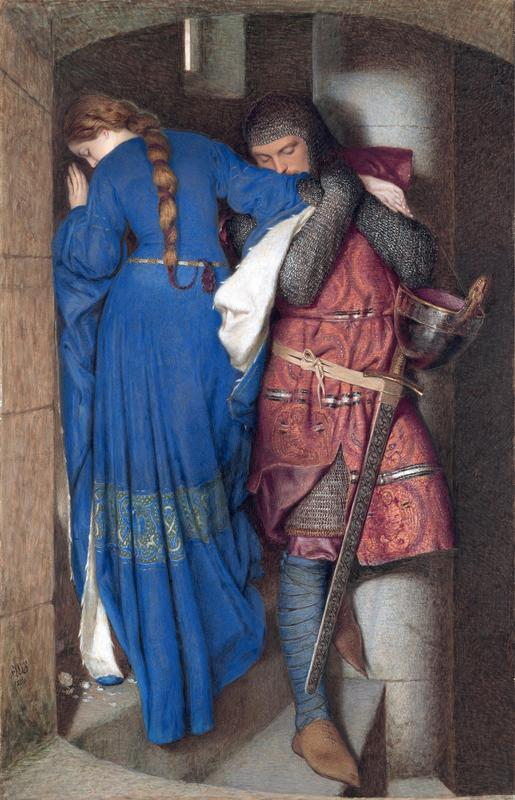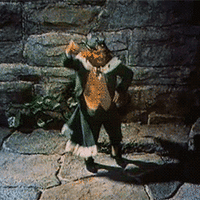More about Hellelil and Hildebrand, the Meeting on the Turret Stairs

Contributor
Hellelil and Hildebrand represents that adorable moment of intimacy all couples share before a gruesome sword fight with the in-laws.
These two lovebirds outdo the duo of The Kiss with their in-your-face, we-get-it-already affection. Unfortunately, this sweet couple would never be married. Don’t be fooled by the fancy clothing; money couldn’t buy happiness for the doomed pair. A macabre and early demise awaited them, courtesy of Hellelil’s suffocating and disturbingly bloodthirsty family.
The story of Hellelil and Hildebrand appears in a Danish ballad that was translated by Whitley Stokes, one of Burton’s buddies. Apparently a fan of gory, ill-fated love stories, Burton was intrigued. Little did he know that his depressing watercolor would be voted “Ireland’s favorite painting” in 2012. No happy ending? No problem.
Depicting the more lurid details of a story bloodier than The Texas Chainsaw Massacre may have been tempting, but Burton kept his interpretation PG. He opted for a chaste bit of arm-worship in a stairwell, making a tableau that’s 100 percent family-friendly. Burton was a knight, after all— he had a reputation to uphold. Just one detail shows the artist couldn’t resist a good virginity joke: the strewn flowers hint that Hellelil will be literally “deflowered.” Saucy.
Burton’s endearing portrait seems downright callous once the whole story of Hellelil and Hildebrand is revealed. Hellelil’s father was outraged when he discovered their relationship, even though Hildebrand was a prince. Weren’t controlling medieval parents supposed to like that kind of thing? With the best interests of his daughter at heart, Pops ordered his seven sons to murder her sweetheart in front of her. Hildebrand, less than thrilled by his first meeting with his girlfriend’s family, killed six of the seven brothers before he was killed by the seventh.
Hellelil’s surviving brother, with charming familial affection, tied her to a horse and dragged her through thorny underbrush. He then shut her in an equally thorny tower and exchanged her for a bell. This brother of the year rivals Goya’s Saturn Devouring his Son in the “creepy familial atrocity” category. Just when we thought youngest siblings might not always be the spawn of Satan.
If the rumors are to be believed, Burton’s life also had its share of doomed love. Translator Whitley Stokes’ sister Margaret bought this watercolor in 1898. She was also a friend of Burton’s, and seems to have loved him for decades. Letters between Whitley, Margaret, and their mother include constant descriptions of Burton’s well being, cryptic details regarding Margaret’s comportment around him, and Whitley’s tantalizing postscript: “I have burnt your last letter as you desired.”
Seems like a painful case of unrequited love to us. Stokes gifted Hellelil and Hildebrand to the National Gallery soon after her purchase. Holding onto artwork created by the object of your unrequited affection is just too tough. When said artwork is the literal emblem of doomed love, seeing it on the daily in your living room has to be its own brand of torture.
Note to anyone wishing to see this painting in person: Voted Ireland's favorite painting, Hellelil and Hildebrand is just too darned precious to always be on display. At present, it can be viewed on Thursdays from 5:30-6:30 and on Sundays from 2-3. If you happen to be there at any other time, it will be locked away in a cupboard in its home in the stained glass gallery.
Sources
- Bourke, Marie. “”The Meeting on the Turret Stairs“ by Sir Frederic William Burton (1816–1900), R.H.A., F.R.S.W., F.R.S.A., LL.D." The Journal of the Royal Society of Antiquaries of Ireland 141 (2011). http://www.jstor.org/stable/24395948.
- “Frederick William Burton.” Wikipedia. December 7, 2016. Accessed June 24, 2017. https://en.wikipedia.org/wiki/Frederick_William_Burton.
- Froude, James Anthony, and John Tulloch. “A Second Batch of Danish Ballads.” Fraser’s Magazine for Town and Country 51 (1855). Accessed June 24, 2017. https://books.google.com/books?id=_LjE2SZM5qoC&lpg=PA89&ots=nE90eKJQaB&…
- “Ireland’s Favourite Painting: The Meeting on the Turret Stairs.” History Ireland. 2012. Accessed June 24, 2017. http://www.historyireland.com/medieval-history-pre-1500/irelands-favour….
- Stokes, Janette. "Poetic Encounter." Irish Arts Review (2002-) 26, no. 3 (2009). http://www.jstor.org/stable/40421252.
Featured Content
Here is what Wikipedia says about The Meeting on the Turret Stairs
The Meeting on the Turret Stairs (or Hellelil and Hildebrand, the Meeting on the Turret Stairs) is a watercolour painting from 1864 by Frederic William Burton. It was painted in London, where Burton later became Director of the National Gallery. The painting is housed in the National Gallery of Ireland, in Dublin.
It was voted by the Irish public as Ireland's favourite painting in 2012 from among 10 works shortlisted by critics.
Check out the full Wikipedia article about The Meeting on the Turret Stairs













